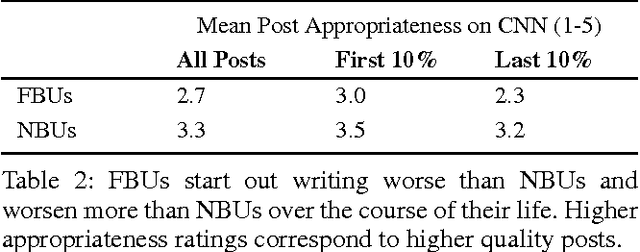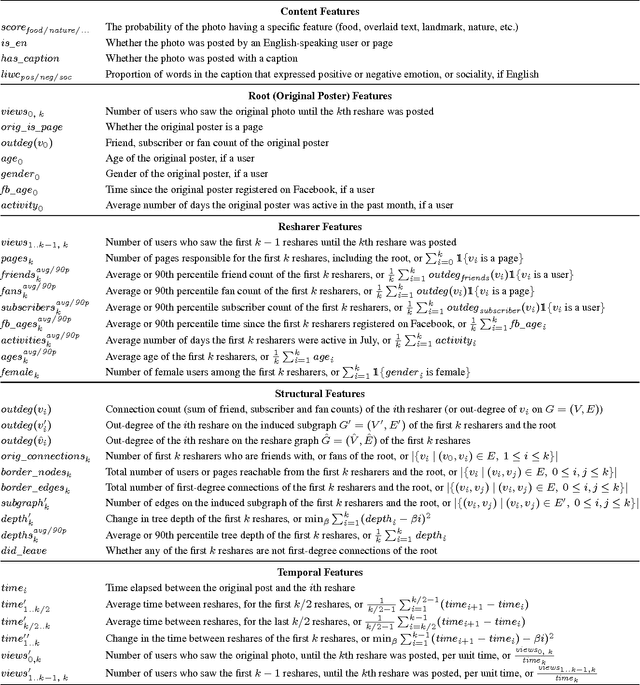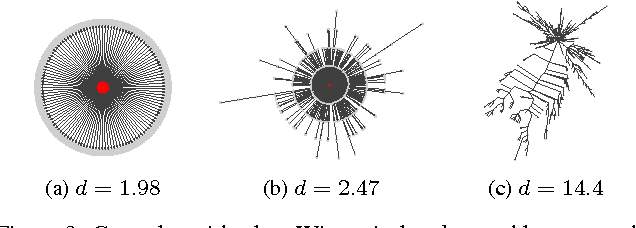Justin Cheng
Don't Let Me Be Misunderstood: Comparing Intentions and Perceptions in Online Discussions
Apr 28, 2020Abstract:Discourse involves two perspectives: a person's intention in making an utterance and others' perception of that utterance. The misalignment between these perspectives can lead to undesirable outcomes, such as misunderstandings, low productivity and even overt strife. In this work, we present a computational framework for exploring and comparing both perspectives in online public discussions. We combine logged data about public comments on Facebook with a survey of over 16,000 people about their intentions in writing these comments or about their perceptions of comments that others had written. Unlike previous studies of online discussions that have largely relied on third-party labels to quantify properties such as sentiment and subjectivity, our approach also directly captures what the speakers actually intended when writing their comments. In particular, our analysis focuses on judgments of whether a comment is stating a fact or an opinion, since these concepts were shown to be often confused. We show that intentions and perceptions diverge in consequential ways. People are more likely to perceive opinions than to intend them, and linguistic cues that signal how an utterance is intended can differ from those that signal how it will be perceived. Further, this misalignment between intentions and perceptions can be linked to the future health of a conversation: when a comment whose author intended to share a fact is misperceived as sharing an opinion, the subsequent conversation is more likely to derail into uncivil behavior than when the comment is perceived as intended. Altogether, these findings may inform the design of discussion platforms that better promote positive interactions.
An Army of Me: Sockpuppets in Online Discussion Communities
Mar 21, 2017



Abstract:In online discussion communities, users can interact and share information and opinions on a wide variety of topics. However, some users may create multiple identities, or sockpuppets, and engage in undesired behavior by deceiving others or manipulating discussions. In this work, we study sockpuppetry across nine discussion communities, and show that sockpuppets differ from ordinary users in terms of their posting behavior, linguistic traits, as well as social network structure. Sockpuppets tend to start fewer discussions, write shorter posts, use more personal pronouns such as "I", and have more clustered ego-networks. Further, pairs of sockpuppets controlled by the same individual are more likely to interact on the same discussion at the same time than pairs of ordinary users. Our analysis suggests a taxonomy of deceptive behavior in discussion communities. Pairs of sockpuppets can vary in their deceptiveness, i.e., whether they pretend to be different users, or their supportiveness, i.e., if they support arguments of other sockpuppets controlled by the same user. We apply these findings to a series of prediction tasks, notably, to identify whether a pair of accounts belongs to the same underlying user or not. Altogether, this work presents a data-driven view of deception in online discussion communities and paves the way towards the automatic detection of sockpuppets.
Antisocial Behavior in Online Discussion Communities
May 16, 2016



Abstract:User contributions in the form of posts, comments, and votes are essential to the success of online communities. However, allowing user participation also invites undesirable behavior such as trolling. In this paper, we characterize antisocial behavior in three large online discussion communities by analyzing users who were banned from these communities. We find that such users tend to concentrate their efforts in a small number of threads, are more likely to post irrelevantly, and are more successful at garnering responses from other users. Studying the evolution of these users from the moment they join a community up to when they get banned, we find that not only do they write worse than other users over time, but they also become increasingly less tolerated by the community. Further, we discover that antisocial behavior is exacerbated when community feedback is overly harsh. Our analysis also reveals distinct groups of users with different levels of antisocial behavior that can change over time. We use these insights to identify antisocial users early on, a task of high practical importance to community maintainers.
Do Cascades Recur?
Feb 02, 2016



Abstract:Cascades of information-sharing are a primary mechanism by which content reaches its audience on social media, and an active line of research has studied how such cascades, which form as content is reshared from person to person, develop and subside. In this paper, we perform a large-scale analysis of cascades on Facebook over significantly longer time scales, and find that a more complex picture emerges, in which many large cascades recur, exhibiting multiple bursts of popularity with periods of quiescence in between. We characterize recurrence by measuring the time elapsed between bursts, their overlap and proximity in the social network, and the diversity in the demographics of individuals participating in each peak. We discover that content virality, as revealed by its initial popularity, is a main driver of recurrence, with the availability of multiple copies of that content helping to spark new bursts. Still, beyond a certain popularity of content, the rate of recurrence drops as cascades start exhausting the population of interested individuals. We reproduce these observed patterns in a simple model of content recurrence simulated on a real social network. Using only characteristics of a cascade's initial burst, we demonstrate strong performance in predicting whether it will recur in the future.
How Community Feedback Shapes User Behavior
May 06, 2014



Abstract:Social media systems rely on user feedback and rating mechanisms for personalization, ranking, and content filtering. However, when users evaluate content contributed by fellow users (e.g., by liking a post or voting on a comment), these evaluations create complex social feedback effects. This paper investigates how ratings on a piece of content affect its author's future behavior. By studying four large comment-based news communities, we find that negative feedback leads to significant behavioral changes that are detrimental to the community. Not only do authors of negatively-evaluated content contribute more, but also their future posts are of lower quality, and are perceived by the community as such. Moreover, these authors are more likely to subsequently evaluate their fellow users negatively, percolating these effects through the community. In contrast, positive feedback does not carry similar effects, and neither encourages rewarded authors to write more, nor improves the quality of their posts. Interestingly, the authors that receive no feedback are most likely to leave a community. Furthermore, a structural analysis of the voter network reveals that evaluations polarize the community the most when positive and negative votes are equally split.
Can Cascades be Predicted?
Mar 18, 2014



Abstract:On many social networking web sites such as Facebook and Twitter, resharing or reposting functionality allows users to share others' content with their own friends or followers. As content is reshared from user to user, large cascades of reshares can form. While a growing body of research has focused on analyzing and characterizing such cascades, a recent, parallel line of work has argued that the future trajectory of a cascade may be inherently unpredictable. In this work, we develop a framework for addressing cascade prediction problems. On a large sample of photo reshare cascades on Facebook, we find strong performance in predicting whether a cascade will continue to grow in the future. We find that the relative growth of a cascade becomes more predictable as we observe more of its reshares, that temporal and structural features are key predictors of cascade size, and that initially, breadth, rather than depth in a cascade is a better indicator of larger cascades. This prediction performance is robust in the sense that multiple distinct classes of features all achieve similar performance. We also discover that temporal features are predictive of a cascade's eventual shape. Observing independent cascades of the same content, we find that while these cascades differ greatly in size, we are still able to predict which ends up the largest.
You had me at hello: How phrasing affects memorability
Apr 30, 2012



Abstract:Understanding the ways in which information achieves widespread public awareness is a research question of significant interest. We consider whether, and how, the way in which the information is phrased --- the choice of words and sentence structure --- can affect this process. To this end, we develop an analysis framework and build a corpus of movie quotes, annotated with memorability information, in which we are able to control for both the speaker and the setting of the quotes. We find that there are significant differences between memorable and non-memorable quotes in several key dimensions, even after controlling for situational and contextual factors. One is lexical distinctiveness: in aggregate, memorable quotes use less common word choices, but at the same time are built upon a scaffolding of common syntactic patterns. Another is that memorable quotes tend to be more general in ways that make them easy to apply in new contexts --- that is, more portable. We also show how the concept of "memorable language" can be extended across domains.
 Add to Chrome
Add to Chrome Add to Firefox
Add to Firefox Add to Edge
Add to Edge